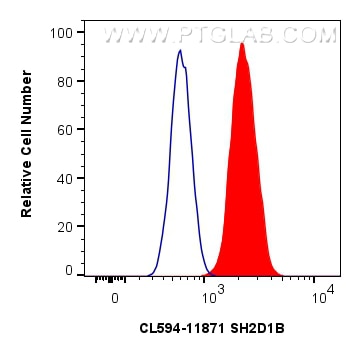CoraLite®594-conjugated SH2D1B Polyclonal antibody
SH2D1B Polyclonal Antibody for FC (Intra)
Host / Isotype
Rabbit / IgG
Reactivity
human, mouse, rat
Applications
FC (Intra)
Conjugate
CoraLite®594 Fluorescent Dye
Cat no : CL594-11871
Synonyms
Validation Data Gallery
Tested Applications
| Positive FC (Intra) detected in | HepG2 cells |
Recommended dilution
| Application | Dilution |
|---|---|
| Flow Cytometry (FC) (INTRA) | FC (INTRA) : 0.40 ug per 10^6 cells in a 100 µl suspension |
| It is recommended that this reagent should be titrated in each testing system to obtain optimal results. | |
| Sample-dependent, Check data in validation data gallery. | |
Product Information
CL594-11871 targets SH2D1B in FC (Intra) applications and shows reactivity with human, mouse, rat samples.
| Tested Reactivity | human, mouse, rat |
| Host / Isotype | Rabbit / IgG |
| Class | Polyclonal |
| Type | Antibody |
| Immunogen | SH2D1B fusion protein Ag2454 相同性解析による交差性が予測される生物種 |
| Full Name | SH2 domain containing 1B |
| Calculated molecular weight | 132 aa, 15 kDa |
| Observed molecular weight | 15 kDa |
| GenBank accession number | BC022407 |
| Gene symbol | SH2D1B |
| Gene ID (NCBI) | 117157 |
| Conjugate | CoraLite®594 Fluorescent Dye |
| Excitation/Emission maxima wavelengths | 588 nm / 604 nm |
| Form | Liquid |
| Purification Method | Antigen affinity purification |
| Storage Buffer | PBS with 50% Glycerol, 0.05% Proclin300, 0.5% BSA, pH 7.3. |
| Storage Conditions | Store at -20°C. Avoid exposure to light. Stable for one year after shipment. Aliquoting is unnecessary for -20oC storage. |
Background Information
SH2D1B, also named as EAT2, an adaptor expressed in innate immune cells, including natural killer (NK) cells. It plays a role in controlling signal transduction through at least four receptors, CD84, SLAMF1, LY9 and CD244, expressed on the surface of professional antigen-presenting cells. EAT-2 overexpression would enhance the innate immune responses and also result in more potent Carcinoembryonic antigen-specific adaptive immune responses.
Protocols
| Product Specific Protocols | |
|---|---|
| FC protocol for CL594 SH2D1B antibody CL594-11871 | Download protocol |
| Standard Protocols | |
|---|---|
| Click here to view our Standard Protocols |


